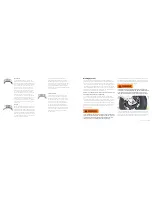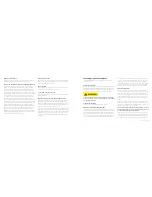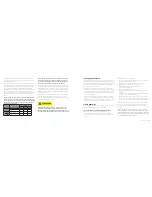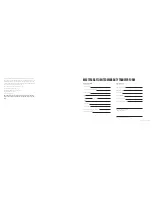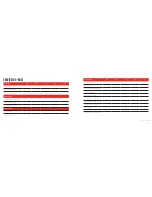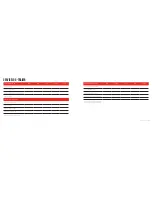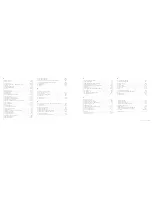
2017 OWNERS MANUAL /
440
DO NOT USE DOT 5 FLUID. (See specific information in Recom-
mended Brake Fluid in this section of this Owner’s Manual.)
• In order for brakes to function properly, all air must be expelled
from the brake system. If bleeding is necessary, have an au-
thorized MasterCraft dealer perform this function or follow the
manual bleeding of the brake system instructions as outlined in
this Owner’s Manual. It is imperative that the system be filled with
only ONE type of brake fluid. Different types do not mix. Follow the
instructions on the brake fluid container.
• Check the safety chains and attachment points for damage or
wear. Repair or replace as necessary.
• Check the breakaway cable for worn or frayed cable strands. End
fittings should be checked for damage. Replace as necessary.
• Check for any hydraulic leaks in the brake system. Be sure all
tube fittings are tight. Periodic checks must be made on all
hoses, brake line tubing and fittings to guard against cuts, worn
hoses and loose fittings that may cause leaks in the trailer brake
hydraulic system. Replace deteriorated and damaged parts as
necessary.
• Check for chips and nicks in the paint. Touch up as necessary.
Ignoring this will lead to accelerated wear and deterioration of the
trailer.
• Check the condition of the bunks. If the coverings show wear,
discuss with an authorized MasterCraft dealer. If the coverings
are not in good condition or if the bunk sub-frame shows any
damage, this will adversely affect the fit of trailer to boat. This
can result in damage to the boat hull, which is not covered under
warranty.
• Verify the coupler latch and all equipment that connect the trailer
and tow vehicle are properly secured and adjusted.
• Verify that there are no leaks in the hydraulic system.
• Verify the safety cables are properly attached to the tow vehicle.
• Verify the emergency brake cable is attached properly to the tow
vehicle.
• Verify the boat is properly loaded on the trailer and properly tied
down to the trailer.
• Verify and/or correct tire pressure on both the tow vehicle and
trailer.
• Ensure the lug nuts are properly torqued. (This must also be done
after the first 25 miles of towing and every 100 miles thereafter,
at a minimum. MasterCraft recommends checking this more
often. At each fuel or rest stop is not excessive.)
• Verify the wheel jack is retracted and in the locked position prior
to towing.
• Verify the tow vehicle has not exceeded the load capacity prior to
towing.
• Check the guide pole bars to ensure they are tight.
• Check that all items are securely fastened on and in the trailer.
Every Three To Six Months Or 250 Miles, Whichever
Occurs First (In Addition To Above)
• Grease the trailer jack.
• Oil the trailer jack handle in accordance with the manufacturer’s
recommendations.
• Examine the entire trailer for any abnormalities or damage.
• Examine the trailer bunks for any signs of abnormal wear.
• Lubricate all the rollers on the trailer with a light coat of oil.
Storage (For Several Months)
• If at all possible, park the boat trailer in a protected, covered
area such as a garage, carport or similar shelter. Keep all canvas
covers on the boat while stored, but in higher humidity areas or
periods of weather, it may be necessary to open a corner of the
covered area to allow air circulation. See the Care and Mainte-
nance section of this Owner’s Manual for additional information
and suggestions regarding storage procedures.
• Have the wheel bearings checked by an authorized MasterCraft
dealer prior to reuse.
• Loosen the tie-downs and winch strap, but be sure the boat is still
resting properly on the hull supports (bunks).
• Remove the drain plug and elevate the trailer tongue slightly (just
an inch or two) to allow water to drain out so the boat will be dry.
Tie the drain plugs from the boat’s bilge system to something
obvious such as the steering wheel so that they will be easy to
remember to re-install before the next outing.
• A good time to touch up rust spots, nicks and chips is when the
trailer is in storage.
• Replace damaged tie-downs, winch straps, wiring, etc.
• Maintain proper tire inflation.
• Shield tires from UV rays (direct sunlight).
• Relieve the load on the tires by supporting the trailer frame with
concrete blocks or jack stands.
• Lubricate moving parts such as the rollers and winch, as well as
the ball coupler.
• Tighten any loose nuts and bolts.
Annually Or Every 2,000 Miles, Whichever Occurs
First (In Addition To The Above)
• To assure the bearings are in good working order, check the bear-
ing adjustment at least once a year by following this procedure:
Jack up one side of the trailer. (Be certain to use jack stands and
chock the trailer wheels to keep the trailer from moving during
the inspection.) Grip the edge of the tire and see if it can be
rocked or moved. If the outer edge of the tire moves more than
1/8” at all, the bearings may need to be readjusted.
• Inspect the tow hitch for corrosion or damage. Repair or replace
components as necessary.
• Check for wear on the hitch ball. If the ball is worn, it is UNSAFE
and must be replaced.
• Check the coupler mechanism for smooth operation. If the latch
handle does not spring open after being disengaged, lubricate
the points on the coupler latch mechanism.
• Check the actuator for excessive wear. If the outer member is
rubbing against the inner, wear marks will show on top of the
coupler just forward of the outer member. Contact an authorized
MasterCraft dealer for replacement parts.
• Check the actuator travel. Excessive actuator travel (over one
inch) when the brakes are applied indicates air in the brake lines.
• Check the brake fluid in the master cylinder reservoir. On the
actuator, remove the cap to the master cylinder reservoir by un-
screwing the cap in a counter-clockwise direction. The brake fluid
level should be 1/8” below the threads.
• Check for foam or bubbles in the brake fluid. If either is present,
drain the fluid from the master cylinder and replace with ONLY
new brake fluid of the same type (DOT 3 is preferred—or DOT 4).
Summary of Contents for NXT20 2017
Page 3: ...2017 OWNERS MANUAL SAFETY KNOWLEDGE ...
Page 27: ...2017 OWNERS MANUAL 48 2017MODEL FEATURESANDSPECS ...
Page 40: ...2017 OWNERS MANUAL 74 DASHESAND VIDEOSCREENS ...
Page 42: ...2017 OWNERS MANUAL 78 XANDXTSERIESINSTRUMENTPANEL 4 3 VIDEOSCREEN XSTARINSTRUMENTPANEL ...
Page 43: ...2017 OWNERS MANUAL 80 PROSTARINSTRUMENTPANEL NXTSERIESINSTRUMENTPANEL ...
Page 58: ...2017 OWNERS MANUAL 110 XANDXTSERIES VIDEOSCREEN OPERATIONSHV450 ...
Page 67: ...2017 OWNERS MANUAL 128 XSTAR VIDEOSCREEN OPERATIONS XSTARINSTRUMENTPANEL ...
Page 80: ...2017 OWNERS MANUAL 154 PROSTAR VIDEOSCREEN OPERATIONS ...
Page 97: ...2017 OWNERS MANUAL 188 NXT OPERATIONS ...
Page 101: ...2017 OWNERS MANUAL 196 NXT20 22 VIDEOSCREEN OPERATIONS ...
Page 107: ...2017 OWNERS MANUAL 208 BOAT OPERATIONS ...
Page 158: ...2017 OWNERS MANUAL 310 PREPARATION ...
Page 172: ...2017 OWNERS MANUAL 338 CAREAND MAINTENANCE ...
Page 204: ...2017 OWNERS MANUAL 402 TRAILERS ...







